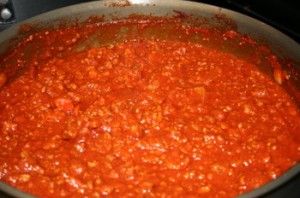Il licopene del pomodoro: meglio un buon ragù o una crema antiaging?Lycopene in tomatoes: better a good sauce or an antiaging cream?
Più potente di una crema antirughe, il ragù di pomodoro, svolge un’azione antiaging sulle cellule epiteliali tramite il Il licopene, un carotenoide contenuto soprattutto nei pomodori rossi. La cottura ne aumenta il potere antiossidante.
D.ssa Chiara Manzi:
C’è una sostanza che protegge la pelle dall’azione dei raggi ultravioletti, infatti è un’efficace antiossidante per l’ossigeno singoletto, il radicale libero più potente, che si produce con la luce e deteriora le cellule della pelle. Questa sostanza facilita inoltre l’eliminazione delle tossine e inibisce la crescita di cellule tumorali, soprattutto se associata alla vitamina E.
Non è un integratore, non si trova nelle creme antirughe, né in costosissime medicine.
La trovate nel sugo di pomodoro, meglio se cotto a lungo!

Il licopene è un carotenoide contenuto soprattutto nei pomodori rossi. Non viene sintetizzato dal nostro organismo ma viene assimilato molto bene dall’intestino. La cottura ne aumenta il potere antiossidante:
il calore lo libera dalle pareti cellulari del pomodoro, aumentando di cinque volte il suo assorbimento intestinale, e rompendo la sua struttura molecolare lo rende maggiormente attivo a livello cellulare. Il grasso di cottura ne facilita l’assorbimento e se tale grasso è un olio ricco di vitamina E l’azione antitumorale del licopene viene potenziata.
Il licopene protegge la nostra pelle molto più di una crema antirughe in quanto penetra all’interno delle cellule epiteliali, laddove le creme agiscono invece solo dall’esterno.
Ecco una tabella che mostra un confronto tra gli alimenti con il maggior potere antiossidanti.
Alimento…………..Licopene……Vitamina C…. BCarotene
(microgrammi)
Pomodoro……………2.573…………..25………………..610
Pompelmo rosa……..1.419…………..31,2……………..686
Papaya………………..1.828………….60,9…………….274
Arancia…………………..–……………53,2………………–
Cocomero…………….4.532……………8,1……………. 303
Fonte: “Antiaging con Gusto, A scuola di cucina per restare giovani.” Sperling&Kupfer 2014More powerful than a wrinkle cream, the meat sauce of tomato, plays an antiaging on epithelial cells through Lycopene, a carotenoid content mainly in red tomatoes. Cooking it it increases the antioxidant power.
Dr. Chiara Manzi:
There is a substance that protects the skin from ultraviolet rays, in fact, is an effective antioxidant for the singlet oxygen, the more powerful free radical, which is produced with the light and it deteriorates skin cells. This substance also facilitates the elimination of toxins and inhibits growth of cancer cells, especially if associated to vitamin E.
It is not a supplement, not found in wrinkle creams, or in expensive medicines. You can find it in the tomato sauce, preferably long cooked!

Lycopene is a carotenoid mainly contained in red tomatoes. It is not synthesized by the body but is absorbed very well by the intestine. Cooking increases the antioxidant power:
The heat releases him from the cell walls of the tomato, increasing of five times its intestinal absorption, and breaking its molecular structure makes it more active at the cellular level. Cooking fat facilitates the absorption and if this fat is an oil rich in vitamin E antitumor action of lycopene is emphasized.
Lycopene protects our skin much more than a wrinkle cream as it gets inside of cells, where the creams instead act only from the outside.
Here is a chart showing a comparison of the foods with the highest antioxidant power.
Food…………………Lycopene……Vitamin C…….BCarotene
(micrograms)
Tomato………………….2,573…………..25…………….610
Pink grapefruit ………. 1,419…………..31.2…………..686
Papaya………………….1,828…………..60.9………….274
Orange……………………..–…………….53,2……………–
Water melon…………..4.532…………….8,1…………..303
Source: “Antiaging con Gusto, A scuola di cucina per restare giovani.” Sperling&Kupfer 2014





Leave a comment